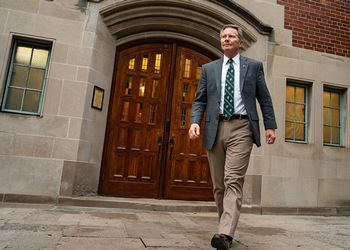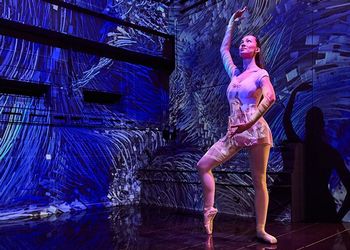Residence Halls: A Key Part of the Total MSU Experience

Though times, tastes and technology have changed, MSU residence halls are on the cutting-edge in providing the best possible service and choices for today’s students.
When alumni revisit campus, they might notice the new MSU skyline—massive new buildings like the Bio-Medical and Physical Sciences Building or the new football tower, now the tallest structure on campus. At night, the Wharton Center’s new steel and glass façade, all aglow, might elicit a “wow” or two.
Most returning alumni also want to check out their former residence halls, perhaps to reminisce about their undergraduate life at MSU. Their time in the residence halls remains perhaps the most unifying experience for most Spartans. On the outside, things have not changed much since 1967, when Holden Hall, the newest residence hall was completed as President John A. Hannah’s postwar building binge crested. But sweeping changes are taking place inside, with innovative design prototypes, new interactive spaces more in tune with the needs of today’s students, greener practices and new food concepts taking hold. There is even new terminology; for example, what students for years knew as an “R.A.”—or Resident Advisor—is now called a “mentor.”
Major changes are unfolding under the leadership of Vennie Gore, who was named MSU assistant vice president for the Division of Housing & Food Services (H&FS) in 2007 after serving at Washington University and three Big Ten universities, Indiana, Illinois and Wisconsin. Gore says his overarching goal, transcending all the services and facilities, is to ensure that students have a great Spartan experience.
Gore notes today’s students are a different breed with different needs than students here a generation or two ago.
“Today’s student is what I call a ‘digital native,’” says Gore, as he tours the new common space, game room and wireless study nooks in Holden Hall, the first residence hall to undergo a major redesign. “There’s a perfect example of what I mean,” he says, pointing to a student sitting in front of her laptop, wearing iPod earphones and texting on her cell phone. “Me, I’m a ‘digital immigrant.’”
Also in the common space area are a very popular private dining area complete with a community kitchen, which students can and do reserve for multiple purposes, an enclosed study area that can serve as a class meeting venue, and lots of little spaces where students can plug in their laptops and study, surf the Internet or play games in the Outlet Room, which comes equipped with a Wii, an Xbox and a Playstation3. Television viewing areas have multiple screens, with audio plug-ins on the seats that allow the viewer to follow the preferred screen. A Sparty convenience store and coffee shop is around the corner, complete with all the convenience products as well as java choices any could want.
This new environment in Holden Hall—distinguishable also by columns wrapped in aluminum spirals—represents quite a contrast from living environments just a generation ago, not to mention the beloved Quonset huts before that, when returning G.I.s swarmed onto campus. The whole concept of space has changed dramatically, and MSU has been a national leader in adapting to the needs of the so-called Millenials—the largest generational group since the postwar Baby Boomers.
Perhaps the most visible change is the advent of electronic technology. Those who lived in residence halls in the pre-Nintendo and pre-Internet era often relaxed by playing ping pong or pool, or engaging in such card games as bridge, pinochle and euchre. Almost all interaction with fellow residents was face-to-face. Today students are just as likely to use an electronic device, whether to send Twitter updates, upload photos to Facebook, play games online, or contact friends via text or cellular phone. If any card game is played, it might be online solitaire.
Also noticeably different today is the diversity of residents, and this has influenced how mentors (R.A.s) are selected. Paul Goldblatt, director of Residence Life, explains the difference.
“We used to find people with good personalities who were good resources for students,” explains Goldblatt. “Now you need a mentor who is also sensitive to diversity—and I use the term broadly to include things like gender identity—who can relate to all kinds of students, and who can address a wide range of issues, even beyond differences in ethnicities, which we are finding is a very minor issue.”
These changes and adaptations at MSU are unfolding within what remains the nation’s largest single-campus residence hall system, with a capacity to house up to 17,500 students. MSU also boasts apartments housing 2,500 students, faculty, and staff, and a dining services program serving more than 50,000 meals daily. Much of this system was erected after World War II to accommodate returning soldiers, who flooded onto campus thanks to the GI Bill®.
“Our average house count currently is 14,362 beds,” says Gore, adding that it’s not an issue of low occupancy. “Back in my day students expected to be doubled or even tripled. Many students today prefer single rooms, so many of our double rooms have been converted into singles.”
Just opened in Fall 2007 are the 300 units in University Village—single student apartments featuring two baths and a kitchen, living room, electricity, cable TV and high-speed Internet access. “These are very popular,” says Gore. “We have to provide these amenities because we need to stay competitive in the marketplace.”
Brody Complex to the West, once known as “the largest non-military dining facility” in the nation, is undergoing a multi-million-dollar renovation that will distinguish it more by quality than size alone. Owen Graduate Hall has dramatically renovated its dining area on a scale comparable to the new dining facility between Snyder and Phillips Halls—known as “The Gallery”—which is attracting three times more traffic than originally anticipated.
In all, today’s dining options as well as food selection will stagger the imaginations of those who, just a couple of decades ago, were fed a steady diet of Johnny Marzetti (or Italian baked noodle). Today’s student can eat as nutritious and healthy as he or she wishes, with choices of baked fish, salads, fresh fruit and other sound choices, on top of macaroni and cheese, French fries and brownies. MSU Dining Services is also committed to providing students with locally-grown and organic food options. Through a partnership with the Student Organic Farm, organic produce is offered in Yakeley Dining Service through the Spartan Harvest Program. To the extent that “an apple a day” is the keystone to health, wealth and wisdom, MSU is covered; the Michigan Apple Program provides students with eight types of fresh, locally grown Michigan apples practically year round. Dining Services officials will also accommodate those with specific diet needs.
In the 1960s, students could choose between near identical grills and cafeterias in different halls. Today students can choose between 13 different undergraduate all-you-care-to-eat dining rooms, four Totally Takeout Express locations, one Totally Takeout, unique a la carte options, campus food courts, and Sparty’s convenience stores and coffeehouses. Augmenting the choice are two MSU Dairy Stores (not a part of H&FS). More options are on their way.
Beyond the dining options are increased choices about the environment of one’s specific wing. There are “quiet” options, for example, where residents determine there will not be excessive hoopla or noise-making during certain times. There are “alcohol free” options, such as in Rather Hall. There are single-sex and co-ed environments. There are areas for students interested in international languages, including American Sign Language. “It’s almost getting to where we can go the route of these dating services and match roommate compatibility,” says one H&FS official. The only lifestyle option not available is smoking, as the entire campus has been declared non-smoking.
Incidentally, one highly publicized MSU option is Jacuzzis. Gore is not convinced that is an option. “I’ll have to check on that,” he laughs. Actually, for the record, there are no Jacuzzis in individual residence hall rooms. But they do exist in public, non-community rest rooms in Shaw, Mason and Abbot Halls.
MSU’s residence hall system is directed by Angela Brown and falls under the Division of Housing and Food Services (H&FS), which reports to Fred Poston, MSU vice president for Finance and Operations. But, H&FS encompasses far more than just residence halls. Gore also has responsibility for auxiliary operations including the MSU Union, MSU Bakers, Concessions, 20 retail outlets, Athletic Catering and Event Services, Food Stores, Spartan Linen Services, Conference Services, Breslin Student Events Center, Forest Akers Golf Courses, MSU Tennis Center, Kellogg Hotel & Conference Center, Cowles House presidential residence, and the Alumni Chapel. Until its announced closing, Brook Lodge in Kalamazoo also fell under the H&FS aegis. Earlier this year, a new heated, indoor golf range opened—expanding Forest Akers’ award-winning driving range and teaching facilities.
Altogether, H&FS comprises some 211 buildings, including 23 undergraduate halls, 1 graduate hall and 3 apartment villages, and Sparty’s operations at 16 sites. Before Spartan Village was demolished last summer, H&FS boasted 247 buildings. Working closely with H&FS is Residence Life, which falls under the aegis of Lee June, vice president of Student Affairs and Services.
Students not only live in residence halls, nearly 5,000 actually work in the residence hall system. Many of them work in the dining area, as did Kim Wilcox, MSU provost, three decades ago. In the 1970s, Wilcox lived in Holmes Hall and worked four years in the Holmes Hall cafeteria. “Four years!” he exclaims, promptly adding that it was one of his “defining experiences” as an undergraduate. Wilcox worked alongside fellow student Diane Barker, now facilities manager for the East Complex. “The cafeteria life for us was a social life experience in itself, so on and off the job we networked, we had fun and we worked hard,” Barker told The State News in a recent interview.
An important component of residence hall life is the Residence Hall Association (RHA), a kind of on-campus student-government that provides entertainment, including movies and songs for a Karaoke machine, arranges trips and events, and funds a variety of student groups. It might be the most active student organization on campus. Those living in residence halls are a part of RHA.
The entire H&FS unit has undergone a major reorganization under Gore. It’s not because things were not working, says Gore, who compares it to Tiger Wood’s well-publicized swing change. “Tiger was No. 1 in the world rankings when he decided to completely change his swing,” notes Gore. “There was nothing wrong with his old swing, but he wanted to accommodate physical changes in his body. Two years later, after his swing change, he won four majors in a row.”
Gore believes that MSU, like Tiger Woods, is now ready and poised to rise to the highest ranking among college residence hall systems and deliver on his vision of the best possible Spartan experience for students. “We’re focused on one thing,” he explains. “How can we better serve our students?”
Gore says that after having studied many residence hall systems across the country, he believes MSU is unique when it comes to connecting living with learning.
“We do this here at MSU with more focus than most other places,” he notes. “We have a long tradition with residential colleges like James Madison College. Now we have three residential colleges and more specific residential living learning options.”
Gore believes this differential advantage puts MSU at the pinnacle.
“Your college experience is one of the few times in your life when you live with people you didn’t choose,” he reasons. “Well, you can argue you didn’t choose to live with your parents. But it’s an opportunity to learn to live with people who are different. In college you learn in the classroom, but a lot of learning also takes place outside the classroom. You can have leadership experiences, engage in philosophical debates late at night, learn about cultures different than your own, and so on. We provide the connections, the learning connections and the connections among students.”
Goldblatt notes that another thing that enhances the living-learning connectivity is the fact that residential living complex directors report 70 percent to H&FS and 30 percent to an academic unit.
“They have a foot in both worlds,” he notes. “The feedback we get is that students often meet them during academic orientation, then meet them again in the residence hall, which adds continuity.”
Besides enhancing connectivity, Gore and his crew strive for “green” practices as much as possible—although some issues, such as the debate between air dryers and recycled paper, are never-ending.
An example is the $12.7 million renovation of Mayo Hall, MSU’s oldest residence hall, which opened in 1931. “It’s a 100-year-old building and we want to make sure we continue its life,” says Gore. “When these buildings were built, they were built at a time when energy was cheap. One thing we need to do is make sure we put in different kinds of steam valves and look at replacing windows to have better energy efficiency.”
H&FS was recognized on April 9 at the Tri-County Waste Recycling and Awards Program (WRAP) for “Pack Up. Pitch In. Help Out.”—an annual program that helps students increase recycling and reuse at year’s end. The program is a joint partnership with H&FS leaders, MSU Surplus, the Office of Recycling and Waste Management, MSU Bikes, the City of East Lansing and nonprofit groups like Volunteers of America, Teen Challenge, American Red Cross, and others.
The program recycles items like carpet, lumber, paper, plastics, metal futon frames, and accepts donations of nonperishable food, books, clothing, household appliances, bikes, useable furniture and electronics for local charities. Pack up. Pitch In. Help Out. makes a difference both on and off campus, with recycling checkpoints set up inside and outside the residence halls, University Village, University Apartments and in the City of East Lansing at the Hannah Community Center.
Diane Barker, East Complex Facilities manager, is a founder of the 13-year program. She says cooperation has helped increase the role recycling and reuse play in students’ move-out week routines. Since 1996, approximately 120,593 lbs. of clothing and shoes have been donated in the Lansing area. In 2008, the program diverted more than 57.2 tons of material to be recycled or reused rather then being sent to the landfill.
As huge as Michigan State is today, virtually all Spartans who attended as undergraduate students share one experience in common—life in a residence hall. From Quonset huts to the sleek, MTV like atmosphere of the renovated Holden Hall, residence halls provided a memorable backdrop where connections were made, learning occurred, and the maturing process was able to proceed.
That principle of personal connection continues to rule the MSU residence halls—no matter how many Internet outlets are around. In fact, today connections are sometimes made even before classes begin. One enterprising student, says Gore, created a Facebook site for her residence hall and hundreds of students joined in, got acquainted, and made friends—all before setting foot on campus.
Changes, renovations and new options, the residence hall experience remains the quintessential component of the MSU experience.



